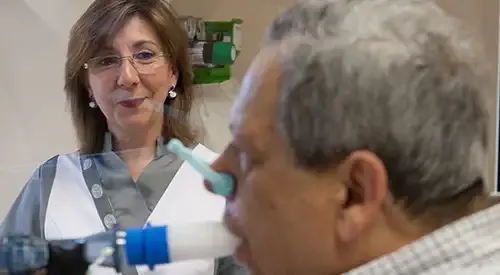Pulmonary hypertension
"There are multiple causes of pulmonary hypertension and knowing the cause is important for deciding treatment and knowing the prognosis".
DR. MARÍA TERESA PÉREZ WARNISHER
SPECIALIST. PNEUMOLOGY DEPARTMENT

Pulmonary hypertension is a pathological situation in which the pressures of the pulmonary circulation (pulmonary arteries) are increased.
The blood pressure in these pulmonary arteries rises to levels much higher than normal. This abnormal high pressure puts too much strain on the right ventricle of the heart, causing it to increase in size.

What are the symptoms of pulmonary hypertension?
The symptoms of pulmonary hypertension are variable and generally consist of shortness of breath that is aggravated by exertion, syncope (loss of consciousness), and chest pain.
The most common symptoms are:
- Breathing difficulty.
- Syncopes.
- Chest pain.
Do you have any of these symptoms?
You may have pulmonary hypertension
How is pulmonary hypertension diagnosed?

The diagnosis of pulmonary hypertension is usually made by an echocardiogram in which signs of increased pressure are seen.
A right heart catheterization is required to measure pressures and assess the severity of the disease.
The evaluation of the disease often requires other diagnostic tests:
- Respiratory function tests.
- Thoracic CT (scan) or angioTAC.
- Ventilation-perfusion scan.
- CBC (kidney function, liver, thyroid, immunity, ...).
How is pulmonary hypertension treated?
In some cases, it is sufficient to treat the cause of pulmonary hypertension. The decision on the type of treatment depends on the cause and severity of the disease.
The most commonly used treatments are administered orally (sildenafil, tadalafil, bosentan, sitaxsentan, ambrisentan) or inhaled (iloprost, treprostinil).
In severe situations, treatment is required by continuous subcutaneous or endovenous infusion (epoprostenol or treprostinil).
In very severe situations, the need for lung transplantation, cardio-pulmonary transplantation or heart surgery (atrioseptostomy) should be considered.
Where do we treat it?
IN NAVARRE AND MADRID
The Department of Pneumology
of the Clínica Universidad de Navarra
Specializing in smoking and tobacco-related diseases, the Department has over 15 years of experience in smoking cessation and lung cancer early detection programs.
The department's specialists have received training at leading centers around the world, including centers in the United States, and have extensive experience in the diagnosis and treatment of all respiratory diseases, both common and rare.
Diseases we treat
|

Why at the Clínica?
- Leading clinical assistance with great work in research and teaching.
- Specialized nursing team.
- We work together with the Sleep Unit and the Lung Cancer Area.







